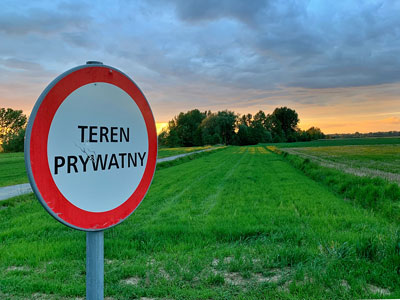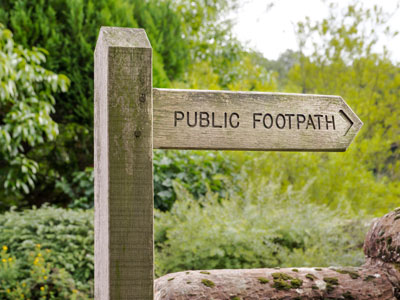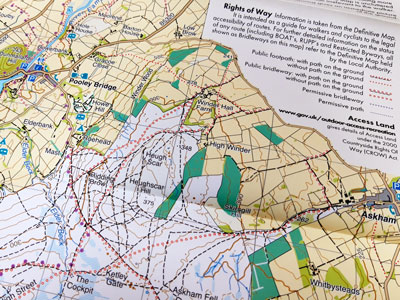Land access and rights of way
by Nigel Williams

England and Wales
The Countryside Rights Of Way (CROW) Act 2000 covers England and Wales. It applies to only 8% of land, which includes areas of National parks, long distance and coastal footpaths, and 3% of rivers. Access land in England and Wales is mapped with a yellow tinge around it on OS maps. Wild camping is not formally permitted without the landowner's permission, although it seems to be tolerated in upland areas if remote and discreet. The countryside code is summed up with 4 elements:
1. respect everyone
2. protect the environment
3. enjoy the outdoors
4. know the signs and symbols of the countryside
Scotland
The 2003 Land Reform Act Scotland enables a right of responsible access to around 90% of Scotland including land, rivers, forests, coastline and lochs for, recreation including wild camping; there are of course some restrictions. It is sometimes quoted as "a right to roam" which strictly speaking it is not. Nowhere in the legislation is that phrase used.
"Responsible access" implies the need for a level of behaviour, understanding nature, valuing and caring for the countryside including respect for others, some of whom earn their living from the land whether through ownership or employment. There is no marking of access land on maps of Scotland. The Scottish Outdoor Access Code (SOAC) is summed up with 3 elements:
1. respect the interests of other people
2. care for the environment
3. taking responsibility for your own actions

Access is more limited than in England and Wales and there is no formal right to access, even over moorland and mountain terrain. Northern Ireland has a lot of agricultural land and often many small fields with boundary walls which it would be difficult to find a way through. Access depends on public rights of way, local government and individual landowners, with some informal access on popular hills and mountain areas such as the Mourne Mountains. Recent reforms allow right of access to publicly owned forests.
Country codes
In the 1970s I was brought up learning the 10 points of the country code in primary school. In Scotland there was the Oor Wullie cartoon sketches to go with it; today it all seems a lot more complicated. It is challenging for educators to explain "responsible access". The Scottish Outdoor Access code in 2005 had 130 pages, whereas England and Wales used Nick Park's (Wallace and Gromit creator) Creature Comfort animations to explain a short list of points of the country code. However, they are now following Scotland's lead. In February 2022, Nature England produced a much more detailed guidance and advice documentation moving towards the notion of "responsible access", including the part that landowners and managers should play in enabling access.
NatureScot developed a range of resources for schools and outdoor education providers in 2005. Leave No Trace (LNT) is a worldwide organisation aiming to educate outdoor users with 7 Leave No Trace principles. They also offer training packages that may appeal to those trying to deliver access education.

This is a complex area, with rights of way, permissive and non-permissive footpaths and bridle ways, byways open to all traffic, and restricted byways. The map symbols are even more diverse; OS Landranger 1:50,000 scale maps use various styles of pink dashed lines and Explorer 1:25,000 maps use various green dashed lines. There are also orange dashed lines for permissive footpaths and bridleways. HARVEY Maps use a less complicated set of symbols regardless of scale. Then there are coloured boundary lines, National Trails and cycle routes all of which have different signpost symbols. OS, Ramblers UK, Natural England and other websites have full explanations.
A practical difference between the home nation access codes often arises when it comes to walkers, cyclists and horse riders. It is illegal to cycle or ride a horse on a footpath in England and Wales, whereas it is legal in Scotland. So we get uninformed Scottish cyclists getting grief from walkers on footpaths in England, and uninformed English walkers coming north for a walking holiday being upset when they find out cyclists are allowed on Scottish footpaths. The updated Highway Code also applies to most paths, and in all the home nations, cyclists and horse riders could cause the greater harm so have a responsibility to reduce their danger to pedestrians.
Increasingly the term "wheeling" is being used to encompass pedal bikes, ebikes, escooters, mobility scooters, wheelchairs, segways, etc. Across the UK, electric mobility scooters and wheelchairs are permitted to travel at a maximum speed of 4mph on footpaths and pedestrian areas. Ebikes are counted as pedal cycles and come under each home nation's path regulations. Motorized vehicles such as trail bikes (which seem to be a growing issue in many communities due to noise, pollution and path damage) and quad bikes etc, are not allowed on paths or private land without the land owner's permission.
I spent a number of years at Glenmore Lodge, ensuring outdoor leaders became well informed about access legislation across UK, and was a member of the Cairngorm National Park Access Forum for a number of years. There are some issues of mass camping, fires, noise, waste and rubbish at popular beauty spots, but if we look at the overall numbers of people accessing the countryside it is clear the vast majority do enjoy responsible access.
Respect, protect, enjoy and be responsible for your actions sounds like a simple instruction. Education at school and in youth organisations is key both within and across the different home nations, but I acknowledge that the differences and the conceptual nature of the guidance does not make this an easy task.
Return to the Navigation Blog
 FREE UK delivery
FREE UK delivery For Christmas delivery information
For Christmas delivery information 







